
LIVERPOOL GREAT HOWARD STREET
|
After Liverpool Exchange station opened on 13 May 1850 and the East Lancashire Railway (ELR) passenger services started running there in July 1851 Great Howard Street became a goods only station. Improvements costing £48,000 were carried out in 1852. In 1855 Walton prison was opened and the Borough Goal was closed. The LYR approached the Liverpool Corporation with a view to leasing the land and this was agreed by them on 3 March 1858. On Benson’s map of 1860 the Borough Gaol had been demolished and by 1864 an extensive yard had been laid out. Unlike the 1849 goods facilities the yard was at street level and it became known as the ‘low level’ goods yard. To transfer wagons from the high to the low levels there were two steam-powered wagon hoists. In the low level goods yard there were offices sidings and a number of lifting cranes which were recorded on a drawing made from a balloon in 1865. There were also primitive signal boxes north of the canal bridge and at the smithy, north of the west-side wagon hoist.
Liverpool Great Howard Street shown on a plan which was prepared for an accident report that occured on 17 September 1876. Click here to see larger version.
From the Tony Graham collection At an LYR meeting on 11 August 1869 it was recorded in the minutes that a plan for an incline to link the upper and lower yards had been submitted with an estimate of £1,700. In a minute from 23 October 1869 it was recorded that coal owners were to be removed from the line so that it might be used for goods traffic. By 30 November 1869 new steam capstans were in operation making some horses redundant. In 1870 the lower yard was enlarged further and it is probable that a goods shed, located on the west side of the site and shown on a 1876 plan, opened at that time. It was said that this goods shed contained the prison cells of the old basement in the Borough Gaol. The incline would have been operational by the time that the enlargement took place. It allowed wagons to be move between the upper and lower yard without having to use the hoists. In the period 1873-74 new interlocked signal boxes opened at Liverpool Exchange, and Great Howard Street where there were three boxes lettered B, C and D (pre-1873/4 boxes were either interlocked or renewed). Great Howard Street B signal box, still at the smithy, controlled the southern access to the high level yard; C signal box, south of Sprainger Street, controlled the northern access to the goods lines; and D signal box was located near Lightbody Street. It was reported at an LYR meeting on 11 February 1874 that a cellar of the warehouse would be destroyed at Great Howard Street if LNWR plans to widen Waterloo Goods Yard went ahead. The LYR granted permission to the LNWR to proceed. A minute of the LYR meeting on 22 May 1874 noted that a fatal accident occurred at Great Howard Street when two wagons ploughed through the wall of the viaduct and fell into LNWR yard at Waterloo. On 17 September 1876 there was another accident at Great Howard Street when a passenger train was derailed. On a plan that was prepared for the accident Great Howard Street B signal box is shown next to the smithy. Because traffic levels had built up the LYR obtained an Act in 1876 which enabled it to widen the line between Liverpool and Sandhills as a result of which the existing viaduct accommodated four lines. The work was completed by 20 March 1878 although it was not opened until 28 September 1879. A new Great Howard Street D signal box opened for the widening; it was a Gloucester Wagon Company box. On 20 January 1880 the installation of bell communication was approved for the C to D signal boxes and on 2 March 1880 for the C signal box to the Tithebarn Street signal boxes. It was reported at a company meeting on 24 October 1883 that there had been an accident at Great Howard Street which caused the death of a shunt-horse. To prevent future accidents it was agreed that bells should to be attached to the hoists and to levers 3, 7 and 10 in Great Howard Street C signal box. Great Howard Street C signal box remained unchanged, but with the opening of Liverpool Exchange B box it worked to another new, Railway Signal Company, box to the north of Great Howard Street at Love Lane. On the opening diagram it was called Love Lane Junction but it was renamed Liverpool Exchange Junction signal box. To the south Great Howard Street C box worked to Liverpool Exchange B. By 1890 there was a sharp curve in place at the bottom of the incline in the lower yard which connected to sidings. The incline had been installed when the canal was still in use, the sharp curve being required to avoid it. The canal had since been drained and infilled. A travelling crane had been installed behind the shed next to the old, 1845-built Northern Hospital. The crane was at right angles to the shed. There was also a line from the low level goods yard that led underneath both main lines towards Pall Mall, where it turned northwards and ran to a point just short of Chadwick Street, where it forked left into Chadwick Street goods yard. In 1898 a new LYR signal box was opened and named Great Howard Street. It was situated immediately south of Chadwick Street on the west side of the line and was built up from the street below, there being no room for it on railway land. The new box controlled all access to Great Howard Street high level goods yard and replaced the old C signal box. Liverpool Exchange B signal box no longer controlled the access to the south end of Great Howard Street high level yard, but it still controlled the junction from the new 1886 line into Exchange. The new signal box worked to Liverpool Exchange B signal box, to the south, and Liverpool Exchange Junction signal box, to the north. By 1906 the incline had been extended in a straight line over the former canal, almost to Leeds Street. This had probably been done in 1896. A new travelling crane was installed on this line. Part of the yard at its southern end had had been given over to the David Lewis Northern Hospital which was rebuilt between 1896 and 1902. A new line had been installed, leading back under the new 1886 main line to a permanent way yard and new goods sidings. At some date a new goods platform was constructed under the 1886 main line. By 1908 the incline had been extended further towards Leeds Street and a two-siding loading mound installed. The west siding was for ‘Executrix of W.F.Chadwick’ and the east siding for Leeds Fireclay. By 1924 a new yard was in situ. It was located to the east of the hospital and next to Leeds Street. There was also an extra siding leading from the old goods yard, across the incline, to beneath the 1886 main line. There was also a new facing connection from the incline to the east beneath the 1886 main line. At a meeting on 19 December 1934 removal of turntables and portions of sidings in Chadwick Street goods yard, disused since January 1923, was proposed. During the Second World War Liverpool suffered from heavy bombing. On 21 December 1940 five arches were destroyed at Bentinck Street at 00.15. Overnight on 21-22 December 1940, Liverpool Exchange Junction signal box was destroyed and Liverpool Exchange B and Great Howard Street signal boxes were damaged. Whilst Liverpool Exchange B signal box was repaired, it was decided to close Great Howard Street signal box as it was fire-damaged, and the structure may have been weakened. The line to Great Howard Street was out of use from 21 December 1940 to 3 March 1941, when the up slow line was restored, with a bridge and single line – both intended to be temporary - for short trains and small engines only. Both slow lines were restored on 24 March 1941, for light trains only. The temporary bridge was destroyed on 4 May 1941. On 22 June 1941 a single line reopened to Great Howard Street goods yard. Normal working was resumed on 2 May 1942.
On 1 January 1948 Great Howard Street became part of British Railways London Midland Region BR(LMR). On 30 September 1963 Great Howard Street closed to public goods traffic. The goods yard remained in use for either internal BR or private goods traffic. A diesel shunter was photographed in the yard in May 1964. The west-side wagon hoist was still standing, but the east-side hoist appears to have been demolished for some time and may have disappeared in the blitz. In September 1964 Great Howard Street goods yard and ground frame were taken out of use, and the junction at Liverpool Exchange Junction signal box was clipped out of use, but not removed. On 2 May 1965 the junction signals at Liverpool Exchange Junction signal box were removed; it is not recorded if the junction points were removed as well. During 1965 the track from Liverpool Exchange Junction to Great Howard Street high level yard was lifted together with some, but not all, of the track in the low level goods yard. The low level goods yard was turned into a car and lorry park and the incline remained, minus track. The signalmen at Liverpool Exchange No.1 box used to drive their cars up the incline and park behind the box. The main goods shed building remained standing and may have been used for some other purpose. The west-side wagon hoist also remained in place. In 1973, in preparation for the new Merseyrail link line incline, demolition of Great Howard Street goods yard began. Around December 1973, part of the viaduct on which Liverpool No.1 signal box stood was demolished, using explosives, and the top part of the surviving wagon hoist was also demolished. The lorry park was closed, but cars still parked on a rapidly shrinking plot as work progressed. In 1974 the goods shed was demolished and the new incline was constructed. In 1977 the base of the surviving wagon hoist was demolished as part of the landscaping preparations for the opening of the new link line. By 2015 part of the lower yard on the western side of the link line had been developed with industrial units. On the eastern side the site was used for car parking. Sections of wall could still be seen at Chadwick Street. The 8D Association - Dedicated to promoting the history of South Lancashire and North Cheshire railways. Web Site Sources:
Click here to see Liverpool Great Howard Street passenger station See also: The 1886 Liverpool Exchange Approach Lines and |


Liverpool Great Howard Street shown on a six-inch scale map from 1890. The large goods shed seen on the west side of the site dated from 1870. The empty space between the lower yard and the main lines into Exchange had been occupied by the Leeds and Liverpool Canal.
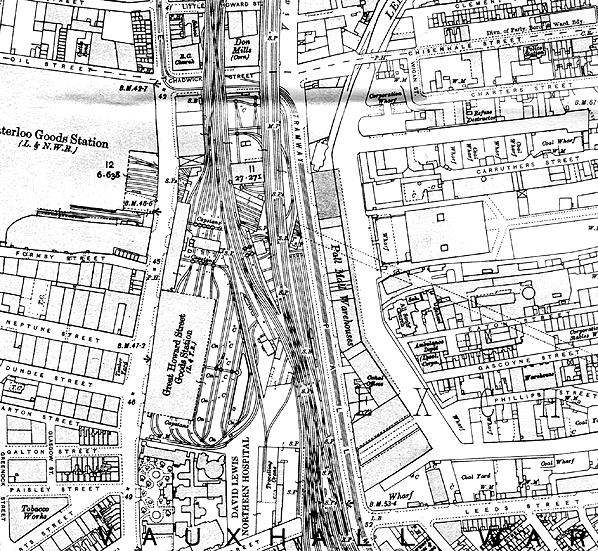
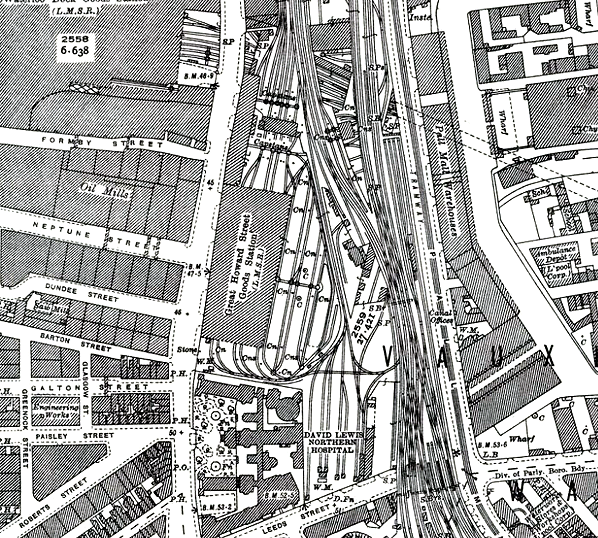
Liverpool Great Howard Street shown on a 1:2,500 scale map from 1924.
 An aerial view of Liverpool Great Howard Street seen in 1935. Both the upper and lower yards can be seen in the view.
An aerial view of Liverpool Great Howard Street seen in 1935. Both the upper and lower yards can be seen in the view.Reproduced with the kind permission of Simmons Aerofilms Ltd

Great Howard Street seen from the air in 1946.
Reproduced with the kind permission of Simmons Aerofilms Ltd

Looking south at the Great Howard Street low level yard from underneath the 1886 Liverpool Exchange approach lines in 1960. Ex-LYR 0-4-0 'Pug' locomotive number 51206 of Bank Hall shed is seen performing shunting duties in the yard. These locomotives were capable of negotiating very sharp curves of which there were many in yards such as Great Howard Street and within the Liverpool dock estate.
Photo by Jim Peden

The low level yard at Great Howard Street seen from the 1886 Liverpool Exchange approach lines in 1960. Standing on the line that linked through to Chadwick Street is ex-LYR 'Pug' locomotive number 51229. The locomotive was based at Bank Hall shed. At the top left of the view can be seen the substation which provided electricity to the electrified lines that ran into Liverpool Exchange.
Photo by Jim Peden
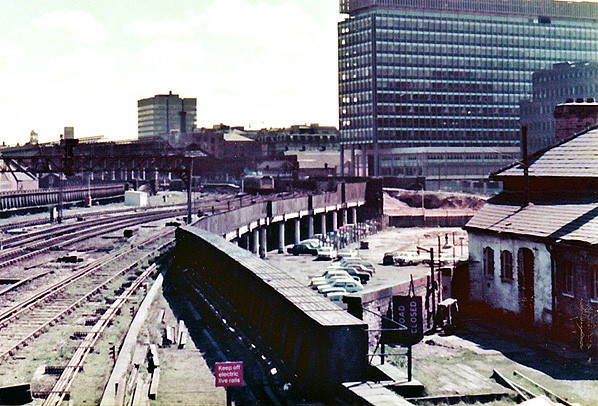 A view looking south from Liverpool Exchange No.1 signal box in the summer 1976. The site of the Great Howard Street lower yard can be seen to the right.
A view looking south from Liverpool Exchange No.1 signal box in the summer 1976. The site of the Great Howard Street lower yard can be seen to the right. Photo by Tony Graham

The site of Liverpool Great Howard Street seen from the southern end of the yard in August 1983.
Photo by John Mann
.jpg) A view looking south along Great Howard Street on 30 March 2015. The upper yard at Great Howard Street Goods station was on top of the 'Grand Arch' which is seen to the left. The lower yard was to the right of it. To the right of the arch there had been wagon hoists that facilitated the transfer of rail vehicles between the upper and lower yards.
A view looking south along Great Howard Street on 30 March 2015. The upper yard at Great Howard Street Goods station was on top of the 'Grand Arch' which is seen to the left. The lower yard was to the right of it. To the right of the arch there had been wagon hoists that facilitated the transfer of rail vehicles between the upper and lower yards. Photo by Paul Wright
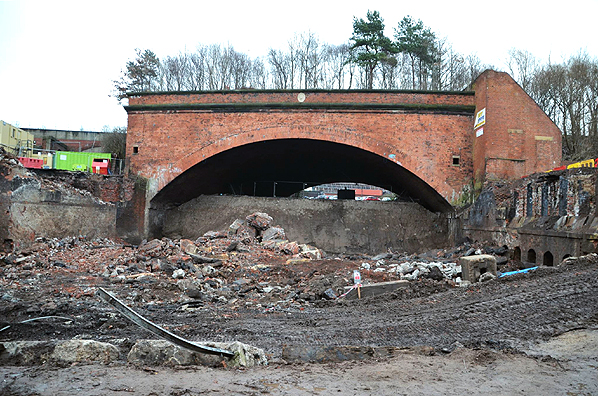
The 'Grand Arch' looking east on 15 December 2016. When the Great Howard Street Goods station first opened it was located on top of the arch and there were hoists to the right of it. The facility expanded over the years towards the right of the view. This view is taken from the site of the LNWR Waterloo Goods station. Such an unobstructed view of this side of the arch had not been seen since 1849 and it was only made possible by the demolition of the Great Howard Street road bridge.
Photo by Paul Frost
Click here to see more photos of the Grand Arch
Click here to see more photos
of Great Howard Street - 1913 to 1976
Click here to see more photos
of Great Howard Street - 1977 to 2015
| Last updated: Sunday, 21-May-2017 14:32:40 CEST |
© 2004-2016 Disused Stations
|
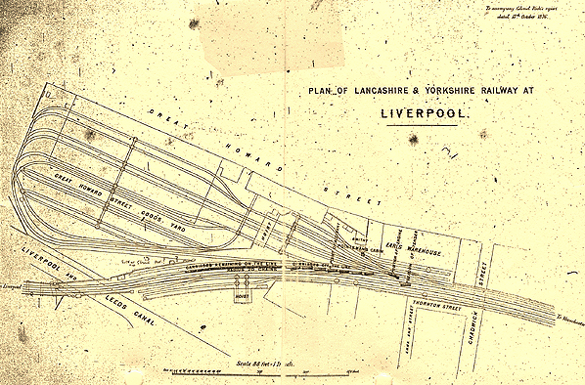
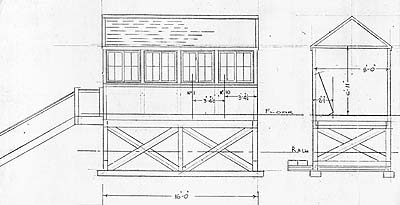 Sometime around 1941 a new Great Howard Street ground frame opened to replace the closed signal box (see plan to the left). The ground frame was an all-wood, LNWR signal hut measuring 16ft long by 8ft wide. It contained a 10-lever LMS REC frame. The blitzed signal box at Exchange Junction was replaced in 1941 with an LMS box housing a 60-lever LMSR REC frame.
Sometime around 1941 a new Great Howard Street ground frame opened to replace the closed signal box (see plan to the left). The ground frame was an all-wood, LNWR signal hut measuring 16ft long by 8ft wide. It contained a 10-lever LMS REC frame. The blitzed signal box at Exchange Junction was replaced in 1941 with an LMS box housing a 60-lever LMSR REC frame.
 Home Page
Home Page